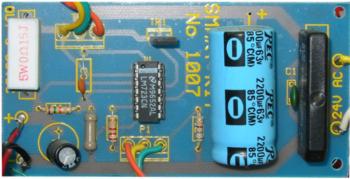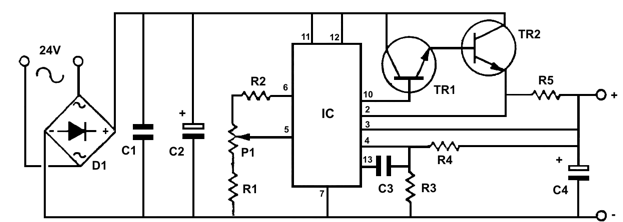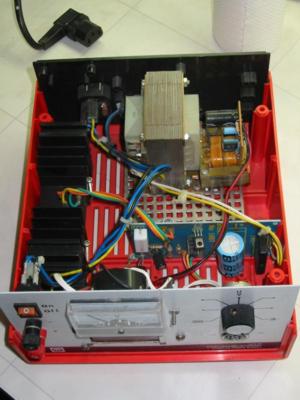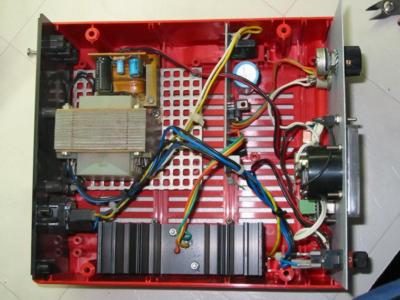3-30 V/2.5 A Stabilized power supply
General Description
This is a very useful project for anyone working in electronics. It is a
versatile power supply that will solve most of the supply problems arising in
the everyday work of any electronics work shop. It covers a wide range of
voltages being continuously variable from 30 V down to 3 V. The output current
is 2.5 A maximum, more than enough for most applications. The circuit is
completely stabilised even at the extremes of its output range and is fully
protected against short-circuits and overloading.
--------------------------------------------------------------------------------
Technical Specifications - Characteristics
Input voltage: 24V DC
Output current: 2.5 A
Output volytage: 3-30V DC
--------------------------------------------------------------------------------
How it Works
The power supply is using a well known and quite popular VOLTAGE STABILIZER IC
the LM 723. The IC can be adjusted for out put voltages that vary continuously
between 2 and 37 VDC and has a current rating of 150 mA which is of course too
low for any serious use. In order to increase the current handling capacity of
the circuit the output of the IC is used to drive a darlington pair formed by
two power transistors the BD 135 and the 2N 3055. The use of the transistors to
increase the maximum current output limits the range of output voltages somewhat
and this is why the circuit has been designed to operate from 3 to 30 VDC. The
resistor R5 that you see connected in series with the output of the supply is
used for the protection of the circuit from overloading. If an excessively large
current flows through R5, the voltage across it increases and any voltage
greater than 0.3 V across it has as a result to cut the supply off, thus
effectively protecting it from overloads. This protection feature is built in
the LM 723 and the voltage drop across R5 is sensed by the IC itself between
pins 2 and 3. At the same time the IC is continuously comparing the output
voltage to its internal reference and if the difference exceeds the designer’s
standards it corrects it automatically. This ensures great stability under
different loads. The potentiometer P1 is used to adjust the out put voltage at
the desired level. If the full range from 3 to 30 V is desired then you should
use a mains transformer with a secondary winding having a rating of at least 24
V/3 A. If the maxi mum voltage output is not desired you can of course use a
transformer with a lower secondary voltage output. (However, once rectified the
voltage across the capacitor C2 should exceed by 4-5 volts the maximum output
expected from the circuit.
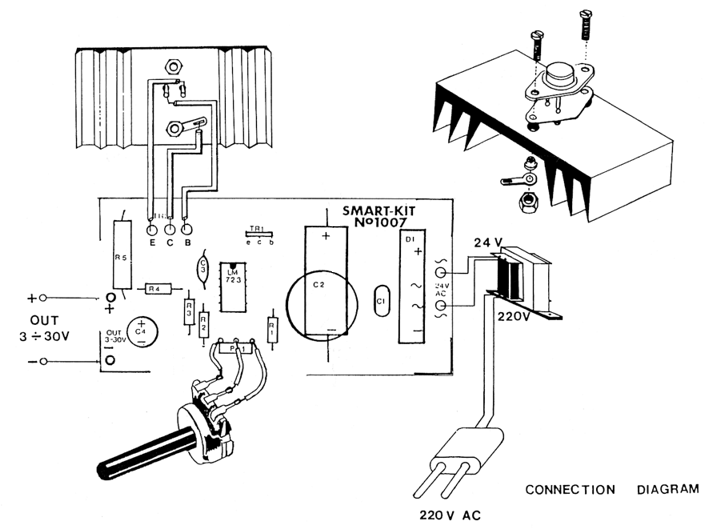
Construction
First of all let us consider a few basics in building electronic circuits on a
printed circuit board. The board is made of a thin insulating material clad with
a thin layer of conductive copper that is shaped in such a way as to form the
necessary conductors between the various components of the circuit. The use of a
properly designed printed circuit board is very desirable as it speeds
construction up considerably and reduces the possibility of making errors. Smart
Kit boards also come pre-drilled and with the outline of the components and
their identification printed on the component side to make construction easier.
To protect the board during storage from oxidation and assure it gets to you in
perfect condition the copper is tinned during manufacturing and covered with a
special varnish that protects it from getting oxidised and makes soldering
easier. Soldering the components to the board is the only way to build your
circuit and from the way you do it depends greatly your success or failure. This
work is not very difficult and if you stick to a few rules you should have no
problems. The soldering iron that you use must be light and its power should not
exceed the 25 Watts. The tip should be fine and must be kept clean at all times.
For this purpose come very handy specially made sponges that are kept wet and
from time to time you can wipe the hot tip on them to remove all the residues
that tend to accumulate on it.
DO NOT file or sandpaper a dirty or worn out tip. If the tip can not be cleaned,
replace it. There are many different types of solder in the market and you
should choose a good quality one that contains the necessary flux in its core,
to assure a perfect joint every time.
DO NOT use soldering flux apart from that which is already included in your
solder. Too much flux can cause many problems
and is one of the main causes of circuit malfunction. If nevertheless you have
to use extra flux, as it is the case when you have to tin copper wires, clean it
very thoroughly after you finish your work. In order to solder a component
correctly you should do the following:
Clean the component leads with a small piece of emery paper.
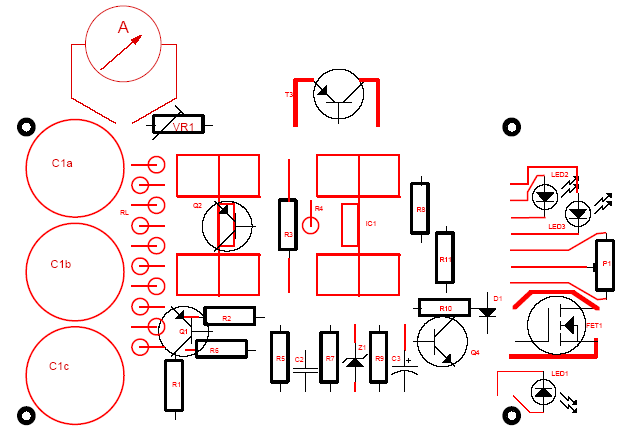
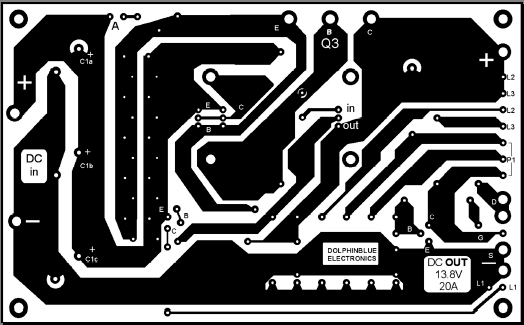
Bend them at the correct distance from the component body and insert the
component in its place on the board. You may find sometimes a component with
heavier gauge leads than usual, that are too thick to enter in the holes of the
p.c. board. In this case use a mini drill to increase the diameter of the holes
slightly. Do not make the holes too large as this is going to make soldering
difficult afterwards. Take the hot iron and place its tip on the component lead
while holding the end of the solder wire at the point where the lead emerges
from the board. The iron tip must touch the lead slightly above the p.c. board.
When the solder starts to melt and flow wait till it covers evenly he area
around the hole and the flux boils and gets out from underneath the solder. The
whole operation should not take more than 5 seconds. Remove the iron and allow
the solder to cool naturally without blowing on it or moving the component. If
everything was done properly the surface of the joint must have a bright
metallic finish and its edges should be smoothly ended on the component lead and
the board track. If the solder looks dull, cracked, or has the shape of a blob
then you have made a dry joint and you should remove the solder (with a pump, or
a solder wick) and redo it. Take care not to overheat the tracks as it is very
easy to lift them from the board and break them. When you are soldering a
sensitive component it is good practice to hold the lead from the component side
of the board with a pair of long-nose pliers to divert any heat that could
possibly damage the component. Make sure that you do not use more solder than it
is necessary as you are running the risk of short-circuiting adjacent tracks on
the board, especially if they are very close together. After you have finished
your work cut off the excess of the component leads and clean the board
thoroughly with a suit able solvent to remove all the flux residues that may
still remain on it.
Start building the circuit by placing the pins on the board and soldering them.
You must be very careful when soldering the components that are going to carry
heavy currents as your joints must be capable of withstanding the maximum
current without getting hot. Solder the IC socket in its place taking care not
to insert it the wrong way round and then put the resistors in their places on
the board. Resistor R5 should be soldered in such a way as to keep its body
slightly separated from the p.c. board to let the air circulate around the
component and cool it. Continue your work with the capacitors. Be careful not to
insert the electrolytic the wrong way round. The polarity is marked on the
capacitors and the p.c. board is also marked accordingly. Insert the rectifier
bridge in its place. The bridge is a heavy duty type and has leads made of
heavier gauge wire than usual. If you have any difficulty inserting them in the
p.c. board you can enlarge the holes with a mini drill. (Automatic production of
p.c. boards requires all the holes on the board to be of the same diameter.)
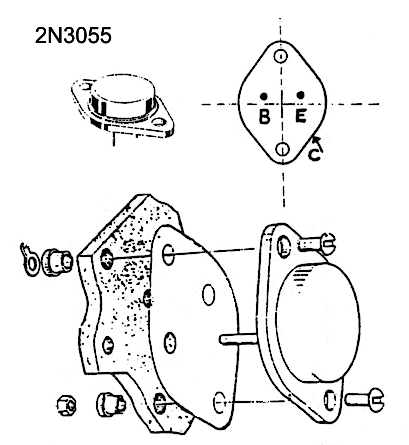
Do not however make the holes too wide as you are going to find soldering the
leads much more difficult afterwards. Solder TR1 in its place and mount TR2 on
the heatsink following the diagram and making sure there is no electrical
connection between the heat sink and the transistor. Don’t forget the insulators,
and use heat transfer compound between the transistor body and the heat sink.
Using heavy gauge wires connect TR2 to the board and finally using a flat ribbon
cable connect the potentiometer with the rest of the circuit. Insert the VOLTAGE
REGULATOR in its socket and your power supply is ready. Now make a final
inspection of your work to ensure that there are no mistakes that could cause a
lot of trouble later. If everything looks OK you can connect the input of the
circuit (it is marked «24 VAC» on the board) to the secondary winding of the
transformer. Connect a voltmeter to the pins marked «OUT 3-30 V» and using a
mains lead connect the primary of the transformer to a convenient power out let.
If everything was done properly the voltmeter should give a reading and turning
the potentiometer should make it change.
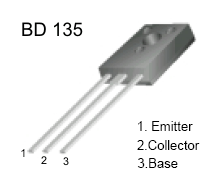
Slight variations from the minimum and maximum voltages specified are normal,
are caused from component tolerances and should not worry you. Although the
circuit works with low voltages and is quite safe to touch any part while it is
in operation it needs a mains transformer to supply this low voltage and the
primary of the transformer is connected to the mains which makes it very
dangerous. The best idea is to use a case for everything in order to make a
complete stand alone power supply for your experiments. Smart Kit also makes a
suitable case for this supply with a printed front panel, ready drilled for the
output connectors, switches, fuse holder and panel instruments.
Parts List
| R1 = 560R 1/4W | C1 = 100nF |
| R2 = 1,2 K 1/4W | C2 = 2200uF 35-40V |
| R3 = 3,9 K 1/4W | C3 = 100 pF |
| R4 = 15K 1/4W | C4 = 100uF/ 35V |
| R5 = 0,15R 5W | |
| D = B40 C3300/2200, 3A rectifier bridge | |
| P1 = 10K potesiometer | TR1 = BD 135 |
| IC = LM723 | TR2 = 2N3055 |
CAUTION
This circuit works from the mains and there are 220 VAC pre sent in some of its
parts. Voltages above 50 V are DANGEROUS and could even be LETHAL. In order to
avoid accidents that could be fatal to you or members of your family please
observe the following
rules:
DO NOT work if you are tired or in a hurry, double check every thing before
connecting your circuit to the mains and be ready to disconnect it if something
looks wrong.
DO NOT touch any part of the circuit when it is under power.
DO NOT leave mains leads exposed. All mains leads should be well insulated. -DO
NOT change the fuses with others of higher rating or replace them with wire or
aluminium foil.
DO NOT work with wet hands. -If you are wearing a chain, necklace or anything
that may be hanging and touch an exposed part of the circuit BE CAREFUL. USE
ALWAYS a correct mains lead with the correct plug and earth your circuit
correctly. If the case of your project is made of metal make sure it is properly
earthen. If it is possible use a mains transformer with a 1:1 ratio to isolate
your circuit from the mains. When testing a circuit that works off the mains
wear shoes with rubber soles, stand on dry non conductive floor and keep one
hand in your pocket or behind your back. If you take all the above precautions
you are reducing the risks you are taking to a minimum and this way you are
protecting your self and those around you. A carefully built and well insulated
device does not constitute any danger for its user. BEWARE: ELECTRICITY CAN KILL
IF YOU ARE NOT CAREFUL.
Here are some photos from this power supply finished and installed in a box.
Title: 3-30 V/2.5 A Stabilized power supply
electronic circuit
Source: smart kit
Published on: 2005-02-03
Reads: 3933
Print version: ![]()
Other electronic circuits and schematics from Power
-
5V/1A Power Supply
-
Solar charger for lead-acid batteries
-
Variable 3 - 24 Volt / 3 Amp Power Supply
-
Pulse Charger for reviving tired Lead Acid batteries
-
Fuse Monitor / Alarm
-
Self switching Power Supply
-
Transformerless Power Supply
-
120 VAC Lamp Dimmer
-
Variable DC Power Supply
-
NiCd - NiMH Charger

